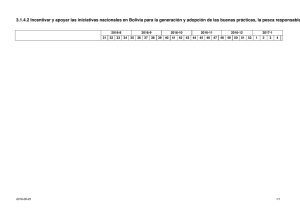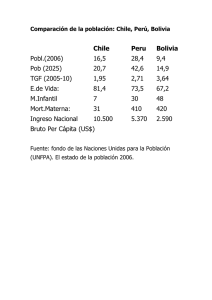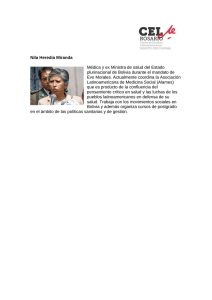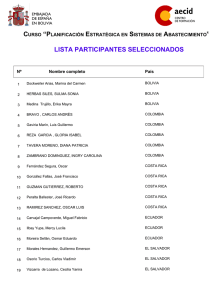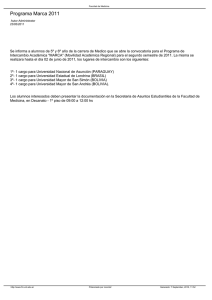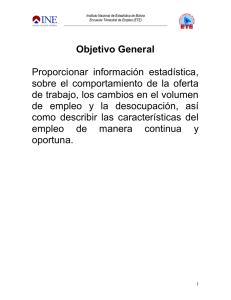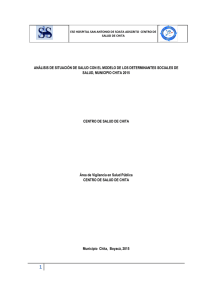¿Qué pasó con Chita?
Anuncio
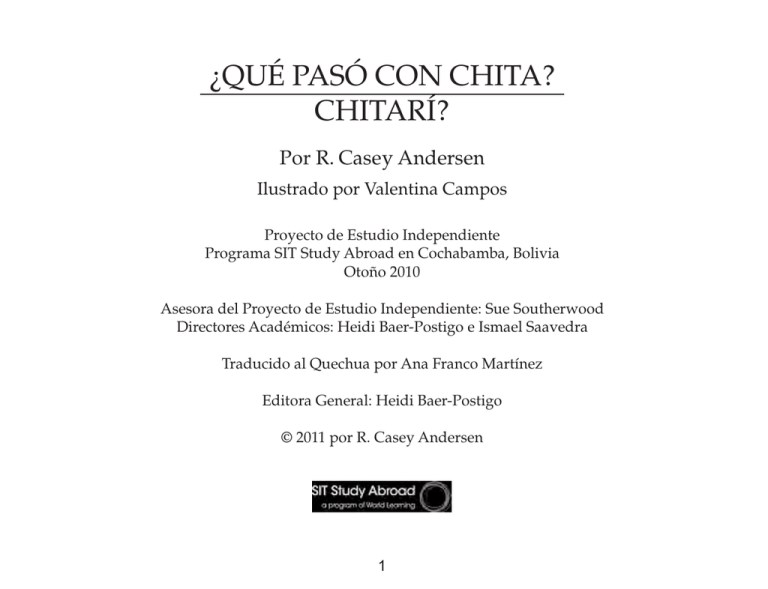
¿QUÉ PASÓ CON CHITA? CHITARÍ? Por R. Casey Andersen Ilustrado por Valentina Campos Proyecto de Estudio Independiente Programa SIT Study Abroad en Cochabamba, Bolivia Otoño 2010 Asesora del Proyecto de Estudio Independiente: Sue Southerwood Directores Académicos: Heidi Baer-Postigo e Ismael Saavedra Traducido al Quechua por Ana Franco Martínez Editora General: Heidi Baer-Postigo © 2011 por R. Casey Andersen 1 2 WHAT HAPPENED TO CHITA? By R. Casey Andersen Illustrations by Valentina Campos Independent Study Project SIT Study Abroad program in Cochabamba, Bolivia Fall 2010 Independent Study Project Advisor: Sue Southerwood Academic Directors: Heidi Baer-Postigo and Ismael Saavedra Quechua translation: Ana Franco Martínez General Editor: Heidi Baer-Postigo © 2011 by R. Casey Andersen 3 Libros Infantiles Bolivia agradece a las siguientes personas por su valioso apoyo y contribuciones al proyecto y a la producción de la colección: Kids’ Books Bolivia thanks the following people for their valuable support and contributions to the project and to the production of the book collection: José B. Alvarez; Marcia & Karl Baer; Jessica Bashford; Antonio Blacudt; Nadine Channaoui; Michelle Dechelette; John Fox; Teodoro Fulguera; Chellis Glendinning; Patricia Parra; Mercedes Pérez; Julio, Maya & Pablo Postigo; Jim Rudolf; Ismael Saavedra; Lisa Schuchart; Sue Southerwood; Gaby Vallejo; Kristine & Steven Walker; Denali Weiler; Adam Weinberg; Gwenn Wells. © R. Casey Andersen, 2011 Autora: R. Casey Andersen E-mail: [email protected] Depósito Legal: ISBN: Queda rigurosamente prohibida, sin autorización escrita del titular del Copyright, bajo las sanciones previstas por las leyes, la reproducción total o parcial de esta obra, por cualquier medio o procedimiento, comprendidos la fotocopia y el tratamiento informático. Diagramación: Manuel J. Zambrana F. Impresión: Talleres Gráficos “Kipus”, telfs.: 4731074 - 4582716, Cochabamba Printed in Bolivia 4 Dedicatoria Este libro está dedicado a los niños del mundo – para que se motiven a actuar. Kayqa Libruqa maypacha umachakunankupaj. q’ala wawaspaj - may purispa Dedication This book is dedicated to the children of the world. May this motivate you to act. 5 Ayni: La inspiración detrás de Libros Infantiles Bolivia Ayni es una palabra quechua que significa reciprocidad. La reciprocidad es una de las características más importantes de la cosmovisión andina, que ha definido la relación del individuo con sus comunidades por siglos. En los últimos diez años, trabajando con mi co-director, en nuestra condición de educadores interculturales de estudiantes norteamericanos en Bolivia, hemos dado un alto valor al hecho de encontrar formas mediante las cuales nuestros estudiantes puedan insertarse en la práctica del ayni para retribuir con algo significativo a este país que nos ha dado generosamente un hogar a quienes vivimos aquí temporal o permanentemente. En lo personal, heredé de mi madre el amor y gusto por la literatura infantil. Espero estar inculcando este amor en mis propios hijos, que son biculturales. He dedicado muchas horas a la búsqueda de libros que cumplan el propósito de afirmar su identidad cultural boliviana. Hay hermosos libros que cumplen este noble fin, pero son pocos y escasos. La mayoría de los libros infantiles son importados e inaccesibles para la mayoría de la población. En el primer semestre del 2008, dos de nuestros estudiantes elaboraron un libro infantil para su Proyecto Final de Investigación. Esta primera experiencia me inspiró mucho para crear Libros Infantiles Bolivia, que contribuye, mediante la producción de libros para niños y niñas bolivianos, a la valoración de sus diversas culturas y también a despertar la conciencia internacional. Desde entonces he tenido el privilegio de guiar a más y más estudiantes que, a través de este proyecto, se insertan en el ayni y se unen a la creciente producción de libros infantiles, como una forma de agradecimiento a este país que los recibe con los brazos abiertos. El libro que el lector tiene en sus manos pertenece a esta colección; espero que lo disfruten tanto como lo hice yo. Heidi Baer-Postigo Fundadora y Directora de Libros Infantiles Bolivia Directora Académica del programa SIT Study Abroad en Cochabamba, Bolivia 6 Ayni: The Inspiration Behind Kids’ Books Bolivia Ayni is a Quechua word meaning reciprocidad in Spanish and reciprocity in English. It is one of the most important characteristics of Andean cosmovisión, or worldview, and has defined and shaped relationships between individuals and communities in the Andes for centuries. For the past ten years, as cross-cultural educators for U.S. college students in Bolivia, my co-director and I have put a high value on finding ways in which our students and our program can truly engage in ayni, i.e., giving something meaningful back to a country that gives so generously to those of us living here both temporarily and permanently. I inherited from my mother a love of children’s literature. This is a love I hope I am instilling in my own bicultural children. I have spent hours browsing through bookstores in search of books that will affirm and celebrate their Bolivian identity. Beautiful examples of such books do exist, but they are few and far between. Most of the children’s books available are imported, expensive, and inaccessible to the majority of the population. In the spring of 2008, two of our students produced a bilingual children’s book for their final Independent Study Project, which was one of the most compelling examples of ayni I have seen. It inspired me to create Kids’ Books Bolivia, a collection that contributes to the production of affordable books for Bolivian children and raises international awareness about their diverse cultures. Since then I have had the privilege of continuing to guide students as they engage in ayni and add to the growing collection of books celebrating the country that hosts them with open arms. The book you are about to read is one of them. I hope you enjoy it as much as I do. Heidi Baer-Postigo Founding Director, Kids’ Books Bolivia Academic Director, SIT Study Abroad program in Cochabamba, Bolivia 7 Cada mañana, apenas sale el sol por las montañas al este, llevo a mis ovejas al río para que pasten y beban. Chita es mi ovejita favorita. Yo le cuento todo. Sapa paqarin niraj sumajta inti llojsisaspaqa ña uywasniyta mayuman yakuta ujyanankupaj, mikhunankupaj apasaniña. Chitaqa munasqay. Tukuy imata paytaqa rimarini. Every morning, just as the sun rises above the mountains in the east, I take my sheep to the river so they can eat and drink. Chita is my favorite one. I tell her everything. Chita significa ovejita en aymara y en quechua corderito huérfano, el débil. Chita means “sheep” in Aymara and “weak one” or “orphaned lamb” in Quechua. 8 9 Hoy le conté del juego de la tunkuña, que cada vez que salto, mi pollera vuela y me tapa la cara. ¡Qué vergüenza! T’unkuña pujllaymanta rimarirqani. Sapa phinkisqaypi pollerayqa mayta phawarichispa, uyayman taparpawan ¡ay mamitay! Mayta p’enqakuni. Today I told her about playing tunkuña, that every time I jump up into the air, my pollera flies over my face. How embarrassing! Tunkuña: coscoja / hopscotch Pollera: falda andina tradicional / traditional Andean skirt 10 11 Reí con Chita. Cuando la abracé, sentí sus costillas. Parecían palitos bajo su pancita lanuda. Chitawanqa asirparini. Ojllajtiyqa lijrajninta may jap’isajtiypis; k’aspisitus jina ukitunpi, wisitan urampi. I laughed with Chita. When I hugged her, I felt her ribs. They felt like rounded sticks under her woolly belly. 12 13 -Mami, ¿por qué está tan flaca la Chita? ¡Antes era bien gordita! -Bueno, es que ahora la tierra está seca. Chita ya no puede encontrar nada para comer, ni agua para tomar. -Mamay imajtin Chitaqa may tullitu? ¡Unayqa sumaj wirita karqa! -Waway, kunanqa jallp’aqa ch’aki. Chitaqa ni yakuta, nitaj mikhunata tarinñachu. “Mommy, why is Chita so skinny? She used to be very big!” “Well, the land is dry now,” she told me. “Chita can’t find food to eat or water to drink anymore.” 14 15 -¿Por qué ya no hay agua? -Nuestra agua viene de la nieve en las montañas. Mira allá. ¿Ves esa montaña grande? Se llama Chacaltaya. Cuando yo era niña, Chacaltaya estaba cubierta de nieve ¡y tenía la pista de esquiar más alta del mundo! Pero ahora ya no tiene casi nada de nieve. -Imarayku niña yaku kanchu? -Pata orqomantapuni yakuqa jamun. Qhawaymá. Jatun orqota rikusankichu? Chakaltaya sutin. Wawa kasajtiyqa, Chakaltayaqa may rit’iwan karqa. ¡Chaypiqa tukuynejmanta rit’ipi suchuj jamuj kanku! Kunanqa manaña ancha rit’iyojchu. “Why isn’t there any water?” “Our water comes from the snow on the mountains. Look over there. Do you see that big mountain? It is called Chacaltaya. When I was a girl, Chacaltaya was covered with snow and had the highest ski slope in the world! But now it has almost no snow at all.” Chacaltaya: Glaciar tropical en los Andes bolivianos que se derritió en el 2009 Chacaltaya: A tropical glacier in the Bolivian Andes that melted in 2009 16 17 -¿Y por qué? -le pregunté suplicando. -Porque la Pachamama está enferma -me dijo con cara de preocupada. -Su fiebre hace derretir la nieve. Tampoco está respirando tan bien como antes. -Imarayku nispa tapurqani. -Pachamama onqojtin, phutiypacha mamayqa niwarqa. -Ruphayninqa rit’inqa unucharpakusan. Nitaj allinta samakusanchu unayjina. “Why, Mommy?” I pleaded. “Because Pachamama is sick,” she said with worry in her face. “Pachamama’s fever is melting the snow. She doesn’t breathe as well as she used to either.” Pachamama: Madre tierra, figura espiritual para los indígenas de los Andes Pachamama: Mother Earth, spiritual figure for the indigenous peoples of the Andes 18 19 -Pero ¿por qué no? -Amorcito, es que hay mucho humo en el aire. La gente ha cortado y quemado muchos árboles para desmontar. La Pachamama está triste y herida. -Imaraykutaj ári? -Wawitay, may millay q’osñi tukuy pachapi. Runaqa mayta sach’asta urmachin, barbechanankupaj ruphachinkutaj. Pachamamataj may phutiyta onqosantaj. “But why not?” “My dear, it is because there is so much smoke in the air. People have cut and burned down many of her trees to clear the land. Pachamama is sad and hurt.” 20 21 -No me gusta cuando el cielo se llena de humo. Me arden los ojos y no puedo respirar bien. Pero tú siempre encuentras maneras de curarme, mamita. -Q’osnilla tukuy pachapi má walejchu. Ñawisniy mayta k’ajachiwan, nitaj sumajta samay atinichu. Qantaj mamitay thañichillawankipuni. “I don’t like it when the sky is covered with smoke. My eyes sting, and it’s hard for me to breathe. But you always find ways to heal me, Mommy. 22 23 -Pensemos en formas para curar a la Pachamama para que la Chita esté saludable otra vez. -Imaynatachus Chitata thañichisunman nispachá purina kanqa, watejmanta walejchakunanpaj. “Let’s think of ways to heal Pachamama so Chita can be healthy again.” 24 25 Los efectos del cambio climático en Bolivia Muchas de nuestras acciones desperdician el agua, como cuando dejamos los grifos abiertos y nos duchamos mucho tiempo. Muchas otras acciones contaminan nuestro planeta y dañan nuestras fuentes de agua. Cuando quemamos y cortamos los árboles que son los que, de manera natural, absorben el humo y atraen el agua, nos estamos deshaciendo de la forma en que el planeta absorbe el humo. Este proceso incrementa el efecto del cambio climático y daña nuestra provisión de agua. En Bolivia, los glaciares se están derritiendo muy rápidamente, causando inundaciones. Después de que terminen de derretirse, no va a haber agua para la gente que vive allí. Un ejemplo es Chacaltaya un glaciar de 18.000 años que empezó a derretirse en los años ochenta y desapareció completamente en el 2009. El cambio climático también ha alterado los patrones de las precipitaciones pluviales. Mientras algunos lugares reciben demasiada lluvia, otros reciben muy poca. Las Naciones Unidas han reportado que el 2010, más de un billón de personas en el mundo no tenían suficiente agua potable. Para el 2025, dos terceras partes de la población mundial vivirán en condiciones de severa escasez de agua. Ya que todos nosotros contribuimos al cambio climático y a la salud del agua del planeta, también tenemos el poder de ayudar a reducir sus efectos. Podemos hacer esto: ✓ Cerrar la pila mientras nos cepillemos los dientes. ✓ Utilizar solamente lo necesario. ✓ Reciclar y reducir lo más posible el uso de agua y otros recursos. ✓ Hacer que la comunidad se dé cuenta del problema del agua y ayudar a otra gente a que comprenda cómo puede contribuir. A pesar de que no podemos parar el cambio climático completamente, podemos actuar para mitigar sus efectos. Cada acción, por pequeña que sea, cuenta. 26 Jallp’awanqa imaynatachus parlana kanqa Ñoqanchisqa imaraykupis yakuta wijch’usanchis. Pilata sut’uspa saqenchis, calletapis ch’uya yakituyan pichanchis, duchapipis mayta suruchinchis; jinata yakutaqa apaykachanchis mana munarisqa jina. Llant’atapis sach’ata urmachispa q’onchata laurachinchis; jinapiqa manaña paramunñachu. Mana sach’as kajtinqa manaña ni paramunñapischu. Jina kaypachapiqa manaña walejatachu pachamamataqa qhawanchischu, chayraykutaj may waj laya jallp’aqa manaña jap’inchischu parlasqantapis. Boliviapiqa may pataspi machu rit’isqa yakuchakusallankupuni má samarispa. Chay yakuqa lucujina ayllusman yaykurparisan para tiempupiqa. Chayraykutaj manañachá yaku kanqachu ni runa ujyananpajpis Chacaltayapi jina: kay machu rit’iqa may unay waranqas wata kawsayniyoj karqa, kunan 2009piqa tukukapusanña suruykuspa. Kunanqa jallp’aqa waj layataña parlarin, manaña kikinchu unayjina. Waj suyupiqa paran, wajpitaj, ch’akin. Manaña sut’ita yachakunchu. Naciones Unidas nisqaqa 2010pi nirqa may supay waranqas runa má sumaj yakuyojñachu. 2025 watapiqa runaqa manaña tukuypaj yaku kanqachu. May phutiy kanqa nin. Mana jinapuni kananpajqa: ✓ Kirusniykita mayllakusajtiykiqa pilata mana sururiychu. ✓ Yakutaqa may qhawarisqata japiy. ✓ Mayllasqaykiwanpis yuritasta, imatapis qharpakuy. ✓ Ayllumasisniykiwan parlanaykipuni kanqa yakuta sumajta qhawanaykichispa; Qhotuchakuspapuni yachakunchis aswan kosata imatapis. Ichá jallpata, pachamamatapis manaña sumajta thañichisunmanchu, jinapis manapuni qonqanachu sumajta yakituta qhawanapuni kanqa. 27 The Effects of Climate Change in Bolivia Many human actions, like leaving the tap running and taking long showers, waste water. Many other actions pollute our planet and damage our water sources. By burning and cutting down trees, which naturally take in smoke and attract water, we get rid of the planet’s way of absorbing smoke. This process increases the effects of global climate change. In Bolivia, glaciers are melting very quickly and flooding the land. After they finish melting, there will be no water left for the people living at the base of the glaciers. One example is Chacaltaya, an 18,000 year-old glacier in Bolivia that started to melt in the 1980s and completely disappeared in 2009. Climate change has also altered rain patterns. While some places get too much rain now, others get too little rain. The United Nations reports that in 2010, more than one billion people around the world did not have enough clean drinking water. By the year 2025, up to two-thirds of the world's population will be living with serious water shortages. Just as each of us contributes to climate change and the health of the planet’s water, we also each have the power to help reduce it. We can do this by: ✓ Turning off the tap while brushing teeth ✓ Using only what is needed ✓ Recycling and reusing water and other resources ✓ Raising awareness in our communities about water issues and helping people understand how they can help. Even though we cannot completely stop climate change, we can each act to soften its effects. Each small action matters. 28 Chacaltaya El derretimiento del glaciar Chacaltaya (antes, la pista de esquiar más alta del mundo) Chakaltaya suruyninpiqa manaña karu runa rit’ipi suchuj jamunchu The Melting of Bolivia’s Chacaltaya Glacier (formerly the highest ski slope in the world) www.travel-bolivia.com/chacaltaya.html 29 Agradecimientos A Heidi, por su dedicación abnegada al libro. A Sue y su familia, por su ayuda tan completa, su apoyo y su guía durante el proceso de investigación y escritura. A la familia Reque-Baldivieso, por su apoyo diario e inspiración. A Valentina, por crear dibujos hermosos para el libro. A Mishu, por sus reflexiones. A Gaby, por enseñarme a escribir un libro infantil. A Mechi, por ayudarme con la traducción. A Chellis Glendinning, por sus creativas ediciones. Sonqoykhumantapacha Heidaman; may libruta tukukunanpaj llank’asqanrayku. Sue ayllumasisnintapis may yanapawasqankurayku, kuskitan ñoqawan llank’aspa, yachakuspa purisqankurayku. Reque-Baldivieso aylluta sut’ichawasqankurayku. Valentinaman libruta k’achanchasqanrayku. Mishutaqa t’ukuchiwasqarayku. Gabymanpis wawa libruta qhelqeyta yachachiwasqanrayku. Mechitaqa waj siminman churaspa. Chellis Glendinningpis sumaj k’achituta libruta llojsinanpaj. Acknowledgements To Heidi for her unfaltering dedication to the book To Sue and her family for their all-around help, support and guidance during the processes of research and writing To the Reque-Baldivieso family for their daily inspiration and support To Valentina for creating beautiful illustrations for the book To Mishu for her insight To Gaby for teaching me how to write a children’s book To Mechi for helping with the translations To Chellis Glendinning for her creative edits 30 ¿Quién ilustró este libro? Valentina Campos es un artista de tercera generación y madre. Ella ha trabajado y ha vivido con campesinos indígenas en varias comunidades que incluye Guaranís, Chiquitanos y tribus Ayoreos, trabajando en proyectos que reafirma viejas formas de arte. En 1999, Valentina co-fundó "Kunaymana", una cooperativa para hacer papel de totora, con mujeres aymaras de Copacabana. Valentina creó una serie de pinturas titulado "Siembra de Mamalas" que refleja los ritos de la siembra, el rol de las semillas mujeres en la cosmovisión Andina y la protección de la diversidad biológica. Valentina ha ido exponiendo esta serie y ha estado presentándose en charlas internacionales; junto a sus pinturas, en espacios de arte, conferencias y universidades. Actualmente ella trabaja en "Uywana Wasi", un centro para el estudio mutuo y afirmación cultural en Cochabamba. Pitaj ilustro libruta qhelqarqa? Valentina Camposqa machu warmiña, artista nisqa. Payqa may q’oñi, chiri campu aylluspi llank’aspa, kawsakuspa purin. Payqa Guaranís, Chiquitanos, tribus Ayoreoswan, ima llank’ananpaj contratanku. Valentinaqa sumajta umachachin, kay maki llank’ayway, arte nisqawan, may unay arte ruasqas mapuni wañunanpaj. 1999 watapi “Kunaymana” wasita sayachiyta yanapakurqa. Totora papelta ruanapaj. Paywanqa aymara warmis llank’anku Copacabanamanta. Chay Pinturasninpiqa, “Siembra de Mamalas”pi may laya jallp’a parlay tarpusqata qhawakun. Warmisqa mujujinata unay kawsayta tarpunku, kay pachanchista; sach’asninta, uywasnintapis, jallp’atapis mikhunallapaj poqochispa maytapuni qhawaspa purinku. Kayta Valentinaqa uyarichispa may karu llajtaspi, universidadespi; parlaspa, rimarispa arten nisqawanpuni puriykacharisan. Payqa “Uywana Wasi”pi, culturata umachakunapaj, artepi llank’anapaj,ima Cochabamballapi aswan puriy. Who illustrated this book? Valentina Campos is a third-generation artist and mother. She has worked and lived with indigenous peasants in several communities and engaged in projects with the Guaranies, Chiquitanos and Ayoreos tribes, designed to re-affirm old art forms. In 1999, Valentina co-founded "Kunaymana", a co-operative of totora paper making with Aymara women from Copacabana . Valentina created a series of paintings, entitled "Siembra de Mamalas", reflecting sowing rituals, the role of women-seeds in the Andean cosmovision, and the protection of biodiversity. She has exhibited this series and has spoken internationally, alongside her paintings, at art spaces, conferences and universities. Currently, she is working on "Uywana Wasi", a center for mutual learning and cultural affirmation in Cochabamba. 31 ¿Quién escribió este libro? R. Casey Andersen vive en Ohio con su familia y asiste a Bates College en Maine, donde estudia el medioambiente. Casey espera que el libro despierte la conciencia sobre el cambio climático e inspire a los niños a tomar acción. Casey fue estudiante del programa SIT Study Abroad en Cochabamba, Bolivia en el otoño del 2010. Pitaj kay libruta qhelqarqa? R. Casey Andersen Ohio ayllusninwan tiakun. Maine jatun yachay wasipi yachakusan. Payqa kay libruta qhelqaspaqa; ichá runaqa waj kawsayta munanman sumaj kawsayta jallp’awan munanman nispa nisan. Caseyqa SIT programapi llank’arqa, Cochabambapi, wayra killapi, 2010 watapi. Who wrote this book? R. Casey Andersen lives in Ohio with her family and attends Bates College in Maine, where she is majoring in environmental studies. She hopes this book will raise awareness about the global issues surrounding climate change and inspire children to take action. Casey was a student on the SIT Study Abroad program in Cochabamba, Bolivia in the fall of 2010. 32 ¿QUÉ PASÓ CON CHITA? ¿Te puedes imaginar lo que le pasa a la pobre y enferma Chita? El cambio climático global está afectando al altiplano boliviano y en este libro conmovedor una niña lucha por entender por qué su ovejita Chita está sufriendo. A medida que su mamá le explica las causas medioambientales que están detrás de la mala salud de Chita, la niña va aprendiendo sobre el calentamiento global en Bolivia. Al entretejer las experiencias de la niña, de la pequeña Chita y de la madre tierra, Pachamama, vas a entender con más profundidad el cambio climático y vas a inspirarte para pensar en algunas formas de ayudar a nuestro planeta. WHAT HAPPENED TO CHITA? Can you figure out what’s wrong with poor, sick Chita? Global climate change is affecting Bolivia’s altiplano, and in this poignant book a girl struggles to understand why her sheep, Chita, is suffering. As her mother explains the environmental reasons behind Chita’s poor health, the girl learns about global warming in Bolivia. By weaving together the experiences of the girl, little Chita, and Mother Earth, you will gain a deeper understanding of climate change and become inspired to think of ways to help our planet.
